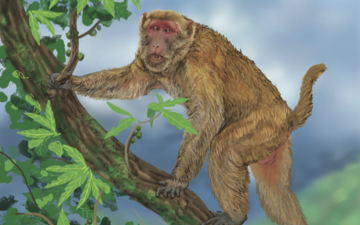The Assam macaque or Assamese macaque (Macaca assamensis) is a macaque of the Old World monkey family native to South and Southeast Asia. Since 2008, the species has been listed as “near threatened” by the IUCN, as it is experiencing significant declines due to hunting, habitat degradation, and fragmentation.[2]
The Assam macaque has a yellowish-grey to dark brown pelage. The facial skin is dark brownish to purplish. The head has a dark fringe of hair on the cheeks directed backwards to the ears. The hair on the crown is parted in the middle. The shoulders, head and arms tend to be paler than the hindquarters, which are greyish. The tail is well-haired and short. Head-to-body-length measures 51 to 73.5 cm (20.1 to 28.9 in), and the tail is 15 to 30 cm (5.9 to 11.8 in) long. Adult weight is 5 to 10 kg (11 to 22 lb).[3]
Assam macaques are diurnal, and at times both arboreal and terrestrial. They are omnivorous and feed on fruits, leaves, invertebrates and cereals.[2] In Namdapha National Park, Arunachal Pradesh, 15 groups were recorded in 2002 comprising 209 individuals. The population had a group density of 1.11 individuals per 1 km2 (0.39 sq mi), and an average group size of 13.93 individuals.[7] During a survey in Nepal’s Langtang National Park in 2007, a total of 213 Assamese macaques were encountered in 9 groups in the study area of 113 km2 (44 sq mi). Troop sizes varied between 13 and 35 individuals, with a mean troop size of 23.66 individuals, and comprised 31% adult females, 16% adult males, and their young of various ages. They preferred maize kernals, followed by potato tubers, but also raided fields with wheat, buckwheat, and millet.[8]
(From Wikipedia, June 2021)




